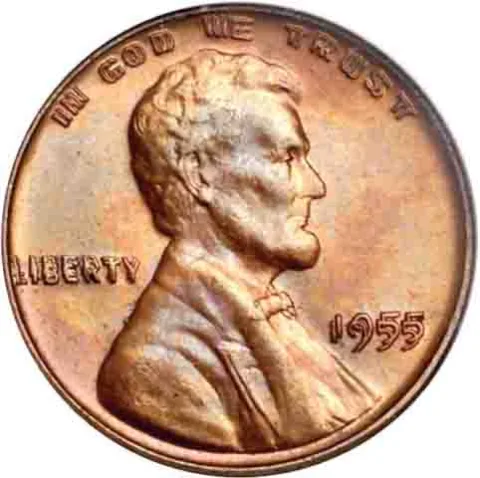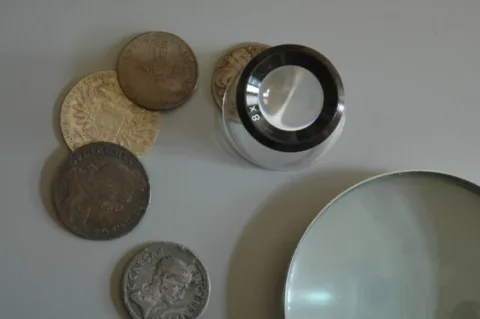Okay, so we know that there are all kinds of coin collectors in the world — and that they all collect different types of coins.
But beyond that, do you know what type of coin collector you are?
That is, how do you define your coin collecting habits?
Believe it or not, there are several types of labels that coin collectors often apply to their specific types of collecting traits.
While a lot of people don’t like to box themselves in with labels, it does help to know what type of coin collector you are — that way you will have a better idea about:
- Which coin collecting clubs & online forums to join or ask questions in
- What kinds of coin dealers to seek out
- What types of coins you should be looking for in coin catalogs and coin magazines
#1 – Type Coin Collectors
When someone asks, “What type of coin collector are you?” you may reply with, “I’m a type collector.”
Saying you are a type collector may sound rather humorous and vague in its own way.
But in fact, type collectors are numerous and belong to a very important and major group of coin collectors.
Type collectors are people who collect one example of every coin, design, denomination, or metal from a certain period of time.
A birth year coin set is one example.
What this means is that type collectors focus less on having every single date-and-mintmark combination from a coin series. They often spend their time trying to get representative examples of coins that belong to a certain time period instead.
While time periods are commonly used as the basis for deciding which coins to collect, collecting all the designs from a certain denomination, country, coin designer, and other similar bounds are common as well.
For example, if you wanted to collect all of the coins from the 20th century, you would need to first identify each of the designs made during those 100 years. Then you would need to collect one example of each of those designs. The same would be true for any type set you intend to build.
#2 – Error Coin Collectors

There are entire groups, clubs, and organizations dedicated to serving the error coin collector. There also are many books and educational videos with the error coin collector in mind. And, there are coin dealers who specialize in error coin collecting.
A lot of people are interested in collecting coins with errors on them. What do I mean by errors?
I am referring to coins that have been struck 2 times — leaving a double-image of some or all of the design on the coin. These are called doubled dies.
Error coins also include coins that are not struck at all (blank coins), partially struck, clipped (leaving a crescent-shaped cut on the coin), and well the list of possible mistakes goes on and on.
If you are interested in collecting coins that don’t look like they are supposed to and the mistake was caused by the Mint, then you are an error coin collector.
#3 – Novelty Coin Collectors
A lot of people who ask questions here at The Fun Times Guide inquire about coins they have which don’t look like common coins.
For example, many readers have asked about these unique coins:
…and a number of other types of interesting pieces that you would not typically find in pocket change.
These coins are usually real, but they did not get struck at the Mint looking the way they now do. Instead, many companies, private individuals, and others have modified or altered the appearance of those coins to honor a special occasion, event, person, or place.
These modifications made to a genuine U.S. coin are collected as novelty coins.
Many numismatists don’t like collecting novelty coins because they simply deem them as being altered coins. However, there is a significant market for novelty coins — the fan base for these often unique coins is large.
You can regularly find novelty coins on the Home Shopping Network, which deals in selling numerous colorized and gold-plated United States coins. Another popular place to find novelty coins would be from a coin dealer who sells novelty coins.
Keep in mind that novelty coins may be neat to look at, but they don’t necessarily make for good investments. Buy novelty coins to appreciate the artistic quality some have, not because you’re hoping to retire from the money you may get by selling them!
#4 – Bullion Coin Collectors
Okay, now let’s talk about coins that do usually make good investments: bullion coins.
Bullion coins refer to investment-level coins struck almost purely from silver, gold, or platinum.
Bullion coins are often found in investment portfolios, but are also popular among coin collectors who appreciate the beautiful designs found on United States bullion coins.
Bullion coin collectors, like bullion investors, must pay careful attention to the value trends of the bullion coins they are buying because the prices for some fluctuate as quickly as the prices for stock shares — no joke.
People buying large quantities of bullion coins may pay a significantly higher or lower price one hour than they may pay the next hour. Of course, that would be on the occasional day when bullion prices are sharply and quickly increasing or decreasing in value.
Bullion collectors tend to collect both the uncirculated (mint) and proof versions of bullion coins, though the proof versions are usually sold with the collector in mind. Proof bullion coins have higher-quality surfaces and sharper strikes than the uncirculated versions of bullion coins.
#5 – Topical Coin Collectors

If you appreciate coins because of the kind of image they have on them, then you may be a topical coin collector. That is, you collect coins because they have designs of certain subjects you like.
If you are a sports fan, you will be chasing after sports-themed coins, such as:
- the numerous Olympic U.S. commemorative coins
- the Jackie Robinson $5 gold commemorative coin
- the 2002 Indiana State quarter bearing the image of an Indy race car
Bird fans rejoice with the image of any U.S. coin with the image of the bald eagle. Canada’s 1967 centennial dollar with an image of a flying goose and the mid-20th century English farthings (with an image of a wren) are 2 other coins the topical coin collector would go after.
And the list of possible subjects goes on.
Topical coin collectors can easily make their own rules and, often, have to travel outside of the United States to find coins that match their subject of interest.
While this may sound challenging, many coin dealers sell foreign coins. Therefore, it makes it easy for topical coin collectors to find the coins they want for their collections.
#6 – Modern Coin Collectors
What exactly is modern?
Well, answering that question depends a lot on whatever you define it to be.
For U.S. commemorative coin collectors, that means any commemorative coin made since 1982 — which is the first year of non-circulating commemorative coinage since 1954.
For collectors of U.S. Colonial-era coins, modern may mean any coin made since 1776.
However, generally speaking, collectors of modern U.S. coins tend to consider any coin made since 1900 as modern — though this definition is not scientific. Modern U.S. coin collecting generally entails pursuing coins like:
- Lincoln cents
- Buffalo nickels
- Mercury dimes
- Walking Liberty half dollars
- Franklin half dollars
- Indian Head pennies (1859-1909)
- Barber coins (1883-1916)
- Other coins well associated with the 20th century
NOTE: Morgan dollars (1878-1921) may or may not fall into the category of modern — it depends on the collector.
#7 – Rare Coin Collectors
Rare coin collectors are those who chase after the scarcest, often priciest coins ever made.
Some enjoy spending a weekend at a coin auction ready to spend thousands of dollars on the most sought-after rare coins that reach the block. Others choose not to go to auctions and instead look for their coins from dealer catalogs and even on the Internet.
Some rare coin collectors don’t buy their coins with any particular design, era, series, designer, or nation of origin in mind. Other rare coin collectors do look to buy rare coins from a certain nation, era, metallic type, etc.
Rare coin collectors may also collect coins that are not necessarily rare but are considered significantly scarcer than most coins (called semi-key coins) — they’re usually plentiful enough to be found in many coin collections.
Rare coin collectors may also seek coins which are highly common in lower grades, but are considered greatly difficult to locate in higher grades.
Other Fun Ways To Collect Coins
The types of coin collectors mentioned above are just the tip of the iceberg. Here are some tips to help you find your own fun way to collect coins:
I’m the Coin Editor here at TheFunTimesGuide. My love for coins began when I was 11 years old. I primarily collect and study U.S. coins produced during the 20th century. I’m a member of the American Numismatic Association (ANA) and the Numismatic Literary Guild (NLG) and have won multiple awards from the NLG for my work as a coin journalist. I’m also the editor at the Florida United Numismatists Club (FUN Topics magazine), and author of Images of America: The United States Mint in Philadelphia (a book that explores the colorful history of the Philadelphia Mint). I’ve contributed hundreds of articles for various coin publications including COINage, The Numismatist, Numismatic News, Coin Dealer Newsletter, Coin Values, and CoinWeek. I’ve authored nearly 1,000 articles here at The Fun Times Guide to Coins (many of them with over 50K shares), and I welcome your coin questions in the comments below!

